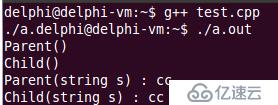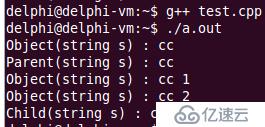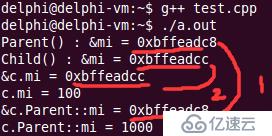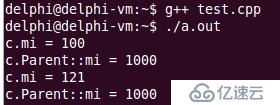您好,登錄后才能下訂單哦!
您好,登錄后才能下訂單哦!
這篇文章給大家分享的是有關C++繼承中構造與析構、父子間的沖突有哪些的內容。小編覺得挺實用的,因此分享給大家做個參考,一起跟隨小編過來看看吧。
Q:如何初始化父類成員?父類構造函數與子類構造函數由什么關系?
A.子類對象的構造
1.子類在可以定義構造函數
2.子類構造函數--必須對繼承而來的成員進程初始化(直接通過初始化列表或者賦值的方式進行初始化,調用父類構造函數進行初始化)
B.父類構造函數在子類中的調用方式
1.默認調用--適用于無參構造函數和使用默認參數的構造函數
2.顯示調用--通過初始化列表進行調用,適用于所有父類構造函數
代碼示例
#include <iostream>
#include <string>
using namespace std;
class Parent
{
public:
Parent()
{
cout << "Parent()" << endl;
}
Parent(string s)
{
cout << "Parent(string s) : " << s << endl;
}
};
class Child : public Parent
{
public:
Child()//對父類構造函數進行隱式調用
{
cout << "Child()" << endl;
}
Child(string s) : Parent(s)//對父類構造函數進行顯示調用
{
cout << "Child(string s) : " << s << endl;
}
};
int main()
{
Child c;
Child cc("cc");
return 0;
}運行結果如圖所示
由該示例和運行結果可以對構造規則進行一個總結:子類對象在創建時首先會調用父類的構造函數,先執行父類構造函數在執行子類的構造函數,父類構造函數可以被隱式調用或者顯示調用
子類對象的構造:1.調用父類的構造函數2.調用成員變量的構造函數3.調用類自身的構造函數
子類構造深度解析
#include <iostream>
#include <string>
using namespace std;
class Object
{
public:
Object(string s)
{
cout << "Object(string s) : " << s << endl;
}
};
class Parent : public Object
{
public:
Parent() : Object("Default")
{
cout << "Parent()" << endl;
}
Parent(string s) : Object(s)
{
cout << "Parent(string s) : " << s << endl;
}
};
class Child : public Parent
{
Object mO1;
Object mO2;
public:
Child() : mO1("Default 1"), mO2("Default 2")
{
cout << "Child()" << endl;
}
Child(string s) : Parent(s), mO1(s + " 1"), mO2(s + " 2")
{
cout << "Child(string s) : " << s << endl;
}
};
int main()
{
Child cc("cc");
return 0;
}運行結果
Object mO1 Object mO2是組合關系,要對父類進行顯式的調用,該打印結果與上面所提的構造順序是相符的
C.子類對象的析構
析構函數的調用順序與構造函數相反
1.執行自身的析構函數
2.執行成員變量的析構函數
3.執行父類的析構函數
代碼示例
#include <iostream>
#include <string>
using namespace std;
class Object
{
string ms;
public:
Object(string s)
{
cout << "Object(string s) : " << s << endl;
ms = s;
}
~Object()
{
cout << "~Object() : " << ms << endl;
}
};
class Parent : public Object
{
string ms;
public:
Parent() : Object("Default")
{
cout << "Parent()" << endl;
ms = "Default";
}
Parent(string s) : Object(s)
{
cout << "Parent(string s) : " << s << endl;
ms = s;
}
~Parent()
{
cout << "~Parent() : " << ms << endl;
}
};
class Child : public Parent
{
Object mO1;
Object mO2;
string ms;
public:
Child() : mO1("Default 1"), mO2("Default 2")
{
cout << "Child()" << endl;
ms = "Default";
}
Child(string s) : Parent(s), mO1(s + " 1"), mO2(s + " 2")
{
cout << "Child(string s) : " << s << endl;
ms = s;
}
~Child()
{
cout << "~Child() " << ms << endl;
}
};
int main()
{
Child cc("cc");
cout << endl;
return 0;
}運行結果
小結:
1.子類對象在創建時需要調用父類構造函數進行初始化
2.先執行父類構造函數然后執行成員的構造函數
3.父類構造函數顯示調用需要在初始化列表中進行
4.子類對象在銷毀時需要調用父類析構函數進行清理
5.析構函數與構造函數對稱相反
Q:子類中是否可以定義父類的同名成員?如果可以?怎樣區分?如果不行,為什么?
代碼示例
#include <iostream>
#include <string>
using namespace std;
class Parent
{
public:
int mi;
};
class Child : public Parent
{
public:
int mi;
};
int main()
{
Child c;
c.mi = 100; // mi 究竟是子類自定義的,還是從父類繼承得到的?
cout<<"c.mi="<<c.mi<<endl;
return 0;
}運行結果
從該示例以及運行結果我們會得出一些疑問,根據繼承的概念,子類擁有父類的所有屬性和行為,在該程序中父類與子類都定義了mi,而在其初始化時,不確定是子類自定義的,還是從父類繼承得到的。造成了父子間的沖突。
A.父子間的沖突
1.子類可以定義父類中的同名成員
2.子類中的成員將隱藏父類中的同名成員
3.父類的中的同名成員依然存在于子類中
4.通過作用域分辨符(::)訪問父類的同名成員
同名成員變量深度分析--代碼示例
#include <iostream>
#include <string>
using namespace std;
namespace A
{
int g_i = 0;
}
namespace B
{
int g_i = 1;
}
class Parent
{
public:
int mi;
Parent()
{
cout << "Parent() : " << "&mi = " << &mi << endl;
}
};
class Child : public Parent
{
public:
int mi;
Child()
{
cout << "Child() : " << "&mi = " << &mi << endl;
}
};
int main()
{
Child c;
c.mi = 100;
c.Parent::mi = 1000;
cout << "&c.mi = " << &c.mi << endl;
cout << "c.mi = " << c.mi << endl;
cout << "&c.Parent::mi = " << &c.Parent::mi << endl;
cout << "c.Parent::mi = " << c.Parent::mi << endl;
return 0;
}運行結果
可以從該段代碼的運行結果看出,通過地址值可以很清楚得看出,父類與子類到底調用的是哪個
B:再論重載
類中的成員函數可以進行重載
1.重載函數的本質為多個不同的函數
2.函數名域參數列表是唯一的標識
3.函數重載必須發生在同一作用域中
父子間函數重載實驗
代碼示例及運行結果
#include <iostream>
#include <string>
using namespace std;
class Parent
{
public:
int mi;
void add(int v)
{
mi += v;
}
void add(int a, int b)
{
mi += (a + b);
}
};
class Child : public Parent
{
public:
int mi;
void add(int v)
{
mi += v;
}
void add(int a, int b)
{
mi += (a + b);
}
void add(int x, int y, int z)
{
mi += (x + y + z);
}
};
int main()
{
Child c;
c.mi = 100;
c.Parent::mi = 1000;
cout << "c.mi = " << c.mi << endl;
cout << "c.Parent::mi = " << c.Parent::mi << endl;
c.add(1);
c.add(2, 3);
c.add(4, 5, 6);
cout << "c.mi = " << c.mi << endl;
cout << "c.Parent::mi = " << c.Parent::mi << endl;
return 0;
}
父子間的沖突
1.子類中的函數將隱藏父類的同名函數
2.子類無法重載父類中的成員函數
3.使用作用域分辨符訪問父類中的同名函數
4.子類可以定義父類中完全相同的成員函數
感謝各位的閱讀!關于“C++繼承中構造與析構、父子間的沖突有哪些”這篇文章就分享到這里了,希望以上內容可以對大家有一定的幫助,讓大家可以學到更多知識,如果覺得文章不錯,可以把它分享出去讓更多的人看到吧!
免責聲明:本站發布的內容(圖片、視頻和文字)以原創、轉載和分享為主,文章觀點不代表本網站立場,如果涉及侵權請聯系站長郵箱:is@yisu.com進行舉報,并提供相關證據,一經查實,將立刻刪除涉嫌侵權內容。